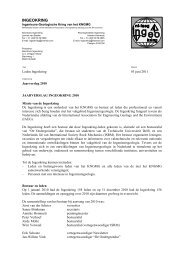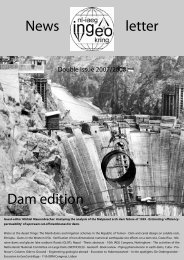environment
environment
environment
- No tags were found...
Create successful ePaper yourself
Turn your PDF publications into a flip-book with our unique Google optimized e-Paper software.
Vol. 11 No. 1 2004<br />
Figure 3: Groundwater flow data<br />
4. Field Experiment<br />
In the beginning of 2004 a field experiment was designed<br />
because the circumstances in the laboratory (for example<br />
temperature, scale, heterogeneity, size of the leak) are<br />
different from the circumstances in the field. The objective<br />
of the field experiment is to see whether a reduction<br />
of the permeability at the location of the leak with a<br />
factor 5 is feasible. In the design representation,<br />
inspection of unwanted leak, costs and possibilities to<br />
monitor were factors that played an important role.<br />
The experiment is currently carried out at the factory<br />
site of Lyondell Chemicals Nederland B.V. at the<br />
Maasvlakte (port of Rotterdam). This location has been<br />
selected because of the presence of sandy subsoil, the<br />
presence of groundwater at reachable depth and the<br />
relationship with Lyondell due to geotechnical soil<br />
investigations in the past. Figure 2 shows a schematic<br />
drawing of the experimental setting. The experiment is<br />
carried out by using three 20ft sea containers, which<br />
are buried with the doors at the top (so 90 degrees<br />
rotated). To avoid the influence of oxygen in the<br />
anaerobic process of reducing the permeability in the<br />
vicinity of the leak, it is necessary to have at least one<br />
meter groundwater above the bottom in the container.<br />
The difference in hydraulic head (3 to 4 meters under<br />
normal circumstances) is being maintained by a<br />
horizontal drain in combination with a pump. The drain<br />
has been constructed in a gravel filter to avoid clogging<br />
near the drain. The fact is that the circumstances nearby<br />
the injection point are similar to those nearby the leak:<br />
streamlines come together and the flow rate increases.<br />
It is therefore not unrealistic that when the permeability<br />
nearby the leakage reduces, this also happens nearby<br />
the drain, which is an unwanted side effect. The large<br />
porosity of the gravel filter has to avoid this potential<br />
problem of clogging.<br />
To stimulate the micro-organism activity, Nutrolase is<br />
injected at various places and various depths by using<br />
an injection method similar to grouting. It is generally<br />
known that by injection of nutrition clogging may occur<br />
near the injection point. During the experiment, after<br />
injecting nutrition water is injected to clean out the<br />
immediate vicinity in order to prevent clogging. Also<br />
the possibility exists to inject the nutrition under high<br />
pressure to be able to reduce the amount of clogs near<br />
the injection point. During the experiment nutrition is<br />
injected several times to reach maximum micro-organism<br />
activity.<br />
The process is monitored by standpipes, a water meter<br />
and several apparatuses to measure chemical properties<br />
of ground water (pH, EC, oxygen, redox potential). A<br />
decreasing redox potential indicates for example an<br />
increasing micro-organism activity and a decreasing flow<br />
indicates a decreasing permeability nearby the leak. A<br />
monitoring plan was designed to collect more<br />
information about the behaviour of the nutrition and<br />
micro-organisms in field conditions. Also it provided a<br />
possibility to be able to make adjustments in the<br />
parameters that can be influenced in case of unforeseen<br />
developments.<br />
At the moment of writing the flow has decreased by a<br />
factor three, so the target of a decrease by a factor five<br />
is not reached yet. In figure 3 the change of the flow in<br />
relation to time is shown. Vertical lines represent the<br />
dates of injection of nutrition. The decline in the flow<br />
between February 20 2004 and February 25 2004 is<br />
caused by setting the stationary head and is therefore<br />
not relevant in relation to the clogging.<br />
5. Discussion<br />
Although the field experiments are not completely<br />
finished yet, BioSealing will provide both the field of<br />
civil engineering and <strong>environment</strong>al geotechnics with a<br />
sustainable method for decreasing permeability of the<br />
soil, which will be useful for the repair of leaks. The<br />
solution is sustainable because use is made of natural<br />
micro-organisms and natural occurring physical,<br />
chemical and biological processes that are stimulated<br />
11




